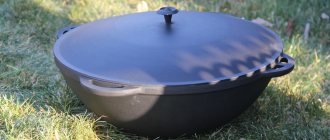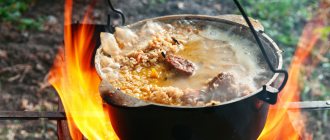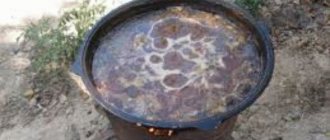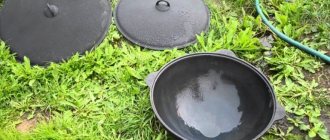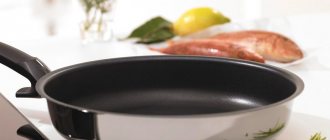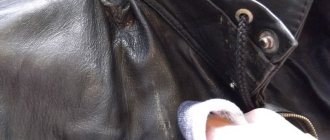A new cast iron cauldron is a good purchase. This utensil is indispensable for cooking meat and fish; dishes cooked over a fire are especially successful. Although it can also be used on a gas stove. The uniqueness of a cast iron cauldron is dictated by the material from which it is made. Cast iron has a very dense structure - food is cooked by simmering, rather than boiling or frying. As a result of simmering, food receives a bright aroma and unique taste.
To successfully use a cast iron cauldron for its intended purpose, it must be properly prepared before first use - calcined or fired. This will help prevent food from burning and giving it an unpleasant taste. Let's talk about how to properly prepare a new cast-iron cauldron for its first use in various conditions.
What is the point of calcining a cast iron cauldron?
The special preparation of a cast iron cauldron for the first use is dictated by the method in which cast iron products are produced - casting and pressing. During the manufacturing process, all molds are generously lubricated with machine oil. This technical liquid helps remove the finished product from the mold without deformation. An additional effect of the oil is to protect the cast iron product from corrosion. Cast iron is a material that quickly rusts when exposed to moisture or chipped.
During the process of strong heating - calcination or roasting, the remaining machine oil evaporates from the surface of the cast iron cauldron.
If you omit the procedure for preparing the cauldron before the first use, machine oil residues will end up in the food every time you cook. Such food can be hazardous to health, and simply taste unpleasant.
Care Tips
After processing a new cauldron, you must adhere to the rules for caring for it. They are as follows:
- After cooking, it is better to transfer hot food to another container.
- Be sure to thoroughly clean the cast iron from food residues and rinse without detergents.
- Wipe dry and put back in place.
The dishes should not be wet during storage; it is advisable to wipe them with a dry cloth from time to time. When using aggressive detergents, the non-stick properties may be lost, so you can treat the product with oil again. Cast iron cookware is very reliable and if you know how to store the cauldron correctly, it can last forever.
It is important to remember that annealing is useful not only for new cookware. The procedure is recommended if there are burnt food residues on the cauldron. If abrasive products are used, the dishes must be burned, then a layer of oil must be built up.
Calcination rules
Proper preparation of a cast iron cauldron before first use consists of thoroughly cleaning it and heating it strongly. It is recommended to use salt. Typically, a cast iron cauldron has a very large volume - from 5 liters or more. Street options start from 10 liters. It is difficult to heat such a cast iron cauldron at home. In the process of preparing for the first use, soot and fumes are formed, the oil is mixed with salt and can be splashed in all directions. Is it dangerous. If possible, it is recommended to move the process of preparing the cauldron for the first use to fresh air.
How to heat a cauldron from rust?
To remove rust, the product is calcined, then it is allowed to use sandpaper with different levels of abrasive. Calcination makes cleaning easier. After removal, a layer of oil is created and baked at 250 degrees for an hour.
Removing rust from a cast iron cauldron
For cast iron, chemical compositions from the store with further oil firing are suitable. You can also soak the product in water with a high vinegar content for 30 minutes. Next, calcination and creation of an oil film with firing are carried out.
First, let's clean the cast iron cauldron
The first step in preparing a cast iron cauldron for first use is thorough cleaning. You can use any non-abrasive cleaner suitable for dishes. The main problem is that you will not be able to clean the cast-iron surface of the cauldron well. Its pores already contain microscopic particles of rust that prevent the formation of a protective film.
To improve the quality of preparing a cast iron cauldron for the first use, salt is suitable. Only this product can be used. 1-2 kg of salt is enough for a cauldron, the volume of which is 6-10 liters. You will need an additional tool - an iron slotted spoon. It should be rigid enough not to bend when stirring the salt.
Procedure:
- prepare the hearth, put firewood;
- place a clean cast iron cauldron on it;
- pour salt into a cauldron;
- make a fire - it is necessary to maintain a medium-power fire;
- Stir the salt constantly during heating;
- landmark - the salt will turn brown. This means that the oil from the pores of the cast iron has mixed with the spice;
- put out the fire and leave the cast-iron cauldron to cool along with the salt;
- Clean the cast iron cauldron using napkins or cotton towels. Be sure to be dry!
Preparing for first use
Whatever material your cauldron has, it needs to be washed after the store.
Use cleaning products available to you. It is important to remove the preservative grease that was applied by the factory. This lubricant, if it gets into food, will not do anything good. For a cast iron cauldron, it is necessary to do firing.
Unlike aluminum cookware, where a protective film of oxides forms even at room temperature, cast iron needs protection. Without a protective film, cast iron cookware will rust.
You can read how to clean a cauldron from rust here.
In addition, food burns to untreated cast iron and quite seriously. The protective film will act as a non-stick coating using the technologies of the past.
And lastly, without a protective film on cast iron cookware, an unpleasant iron taste gets into the dish.
How to get this necessary protective film?
This can be achieved through the traditional calcination of a cast iron cauldron with oil.
Calcination applies exclusively to cast iron cookware.
Firing in oil
Firing with oil is the process of preparing a cast iron cauldron for first use, which promotes the formation of a protective smooth film. It is formed during the burning of cast iron to oil. Don’t be afraid of burning - such burning will not impart any unpleasant taste or smell to the future dish.
To fire a cast iron cauldron before the first use, use any vegetable oil of your choice or animal fat. For a cast iron cauldron with a volume of 5-10 liters you need to take about 250 grams of oil or fat.
Before firing, the cast iron cauldron should be prepared - dried if it was wet. This can be done with towels or napkins.
The procedure for firing a cast iron cauldron (takes about half an hour and requires caution):
- place the cast-iron cauldron on the fireplace with firewood, pour out the entire portion of the prepared oil;
- light the fire, keep the heat at medium level;
- This stage of preparation for the first use requires special care - the oil must be distributed over the walls of the cauldron. Use a slotted spoon or spatula for these purposes. You can act by tilting the vessel in different directions. It is important to avoid hot fat overflowing the edge of the cauldron and getting the flammable mixture onto the fire;
- During the process of heating a cast iron cauldron, it is important to ensure that the walls remain wet from oil at all times. As soon as drying occurs, it is necessary to coat or pour over them again;
- after 30-45 minutes, turn off the fire and let the oil cool, then drain;
- Dry the surface of the cast iron cauldron thoroughly with dry towels or napkins. It is better to thoroughly rub the remaining fat into the walls.
Before cooking for the first time, do a test - boiling water in a cast iron cauldron. If the liquid does not have turbidity or impurities, the procedure for preparing the cast-iron cauldron for the first use was carried out correctly and new dishes can be prepared.
How to check a heated cauldron?
How to fire a new cast iron cauldron and check the correctness of firing? You need to get a color without dullness, saturated. If it is uneven, the light will not be reflected correctly. There should be no rust. To check, moisten a napkin with oil and wipe the bottom and edges with it. There shouldn't be any traces. If there is a brownish coating, oil firing is repeated. Aluminum can only be checked by the absence of carbon deposits on the walls.
Rust from the cauldron
Proper removal will extend the service life, avoid damage and other defects.
Soot and carbon deposits from the cauldron
If you can’t wash it with hot water, add a little baking soda. In nature, it is good to use river sand. Hot water removes food residues well, but removing carbon deposits with a fork or knife is unacceptable.
Fat from a cauldron
Eliminated with hot water, river sand, using boiling with the addition of a small amount of ordinary soda.
Calcination in the kitchen
It is better not to calcinate the house. Such preparation of a cast-iron cauldron for the first use is fraught with a strong burning smell, which may disturb neighbors, the threat of burns and the possibility of a fire. If there are simply no other options for preparing for the first use, you should be especially careful and follow the rules:
- open all the windows and create a draft while the cauldron is being calcined;
- for cleaning, take a smaller amount of salt (500 g), stir it more often when heating;
- if firing is carried out on a gas stove burner, it is recommended to add salt to the oil (proportions 1:1). This will reduce the smoke;
- The best option for firing is an oven.
Further care of the cauldron
It is important to dry the product with a towel and dry it, so all remaining moisture will evaporate. The container can then be removed for storage. For long-term storage, wrap with cloth or parchment. The product should be placed on its side and washed without aggressive chemicals.
How to wash a cast iron cauldron?
Important! Cast iron should not be scratched with sharp objects, but the use of a metal brush, soda and sand is allowed.
Fat-dissolving mixtures are undesirable; they will remove the natural film that prevents burning.
The process of cleaning an aluminum cauldron
Formulations that dissolve fat are acceptable; only products containing oxalic acid are not suitable. They spoil the color of the metal. Abrasives and metal brushes are suitable; soaking or using a dishwasher will not cause harm.
Types of calcination
As already noted, there are several types of firing for preparing a cast iron cauldron before first use. All of them effectively prepare dishes; all that remains is to choose the most convenient one. It is recommended to use both salt and oil for preparation before first use. It is especially effective to use the spice in preparing a cast iron cauldron for the first use - it cleanses and disinfects the pores.
Depending on the location of the procedure - at home (oven, burner) or outdoors (open fire). The most successful option seems to be an outdoor option for preparing a cast iron cauldron for first use. It goes faster and it’s easier to keep track of the cauldron.
The goal of any firing is to achieve a uniformly shiny inner surface of the cauldron. Experienced users recommend using twine rather than rags or napkins to clean a cooled dish. A piece of rope is unwound from the coil, which can be twisted into a shape resembling a sponge. Rigid threads effectively clean carbon deposits from cast iron, but do not scratch its surface. You can also use a dense skein of hay.
With any method of preparing a cauldron for the first use, you cannot use water. Even a small temperature change can cause cast iron to crack. The dishes may simply split into two parts. When caring for such metal, water is used in minimal quantities.
Aluminum analogue
Aluminum is a metal from which cheaper utensils are made. This is an active metal that creates an oxide film upon any contact with oxygen. But it also requires preparation for the first use. Simple cleaning with water and any foam that is suitable for dishes will be enough.
Is it necessary to fire an aluminum boiler?
Aluminum is an active metal. And in the open air, under any conditions, a protective oxide film is formed.
When you use it for the first time, you will need to clean such a cauldron from the preservative factory grease. Household chemicals can handle this.
How to properly wash a cauldron is written in this article.
To create a non-stick oil layer, you need to repeat the procedure as for cast iron cookware, but keep the heat low .
Please observe fire safety. A properly processed cauldron will last a long time and will delight you with delicious dishes more than once.
Salt
Before using this method, you must wash the product with a mild detergent. You can take dishwashing gel or laundry soap.
Then wipe dry with a towel or napkins and begin using this burning method.
How to properly heat a cast iron cauldron:
- You will need 1 pack of salt, which is poured onto the bottom of the dish. It should completely cover the bottom of the product.
- Place the dishes on the stove and turn on the heat.
- During the process, you need to stir the table salt. When it turns brown, turn off the stove and leave the cauldron to cool. Do not pour cold water or expose it to sudden temperature changes (for example, take it outside in winter).
- When the dishes have cooled, pour the table salt into a garbage bag and wipe the surfaces of the product with paper napkins.
After this method, the dishes will shine clean and will be suitable for use.
When stirring salt, wear gloves, preferably high ones, and use goggles and a respirator. Hot salt causes serious burns to the face and eyes if it comes into contact with the skin.
In this way, you can process not only cast iron products, but also aluminum ones. The algorithm of actions is the same.
Salt not only absorbs technical oil, it absorbs all the chemicals that were used in the production of the product.
What methods can you use to properly fire a cauldron?
In the entire history of the existence of cast iron, nothing new has been invented. A cast iron aluminum cauldron is calcined using salt and vegetable oil. The first component retains heat well and absorbs all excess. The second one forms a varnish non-stick film.
There are several types of calcination; you can choose the most suitable one and prepare your kitchen utensils.
Note! If the cauldron comes complete with a frying pan lid, it also needs to be processed. For a regular round lid, salt or dry treatment is sufficient.
With table salt
- The cauldron is placed on the largest burner.
- Fill with coarse salt to a height of up to 3 cm and distribute it evenly along the walls.
- They turn on the fire and wait for the smell of smoke.
- Keep the dishes on the fire for up to 30 minutes.
- The salt is stirred periodically, it will become darker each time (it will absorb the factory grease).
- Leave the cauldron on the stove to cool gradually.
- Pour out dirty salt.
- Wash the inner walls with warm water and laundry soap or mustard powder.
Salt is poured onto the bottom of the vessel and the cauldron is placed on a hot stove or on a fire.
Important! The cauldron is not yet ready for cooking; there is no protective oily film on it. Such cast iron will quickly rust, absorb odors, and begin to smell unpleasant. Creating a non-stick layer is described below.
Oil treatment
The cauldron will require from 300 to 700 ml of oil, depending on the volume. It should cover the bottom by at least 2 cm. During firing, the vessel is constantly turned so that the oil washes all the walls. The processing is carried out over low heat so that the oil does not flare up or smoke too much. Just in case, keep a fire extinguisher nearby. The oil is kept on fire for 40–50 minutes, depending on the size. A large cauldron takes longer to fire.
After this procedure, all remaining contents are drained and the bottom of the container is wiped with a paper napkin.
Important! Hold the cast iron with a regular towel, wrapping it around your hand several times. Mittens are not suitable for hot cast iron, they are too thin. Synthetics will melt immediately.
After the oil has cooled, it is poured down the drain or used for waterproofing impregnation of wood. It is dangerous to use such oil in food, it is almost drying oil. After oil treatment, pour boiling water over the cauldron and wipe dry. You can cook in it!
Thanks to it, food will not burn to the bottom of the cauldron.
Firing in the oven
In an oven preheated to 180 degrees, the cauldron is kept for an hour until the bluish smoke stops oozing from the cracks and the cauldron becomes visible through the glass. It is better to open the oven periodically or turn on the fan mode, if available. You shouldn’t take out hot dishes; it’s better to wait until it cools down completely. Then cool the cauldron and wash it with soap. Dry calcination is only the first stage of cast iron preparation.
Before cooking, you will need to create an oil film on the metal surface.
On an open fire
On a fire, a blowtorch (it is used as a burner), a barbecue, or in an oven, dry firing is carried out without the use of salt and oil. The cauldron is constantly turned over the fire. Where the industrial lubricant burns out, the dishes become grayish and lighter. After all the walls and bottom become uniform, the dishes are thrown from the fire pit onto the grass or into the snow. After this, the cauldron is washed well. Before cooking, it is calcined again, periodically lubricated with vegetable oil.
The procedure is repeated up to 5 times until a dense non-stick coating is formed.
Restoring the non-stick layer after cleaning the cauldron
Treatment will allow you to return the usual properties of the dishes. After thorough cleaning, it will lose its characteristics and food will stick and burn. The usual color is lost.
Tips for restoring the non-stick layer
Washing with warm water, wiping dry, coating with salt and baking will help restore properties. If this has already been done, all that remains is to apply sunflower oil to the inside.
